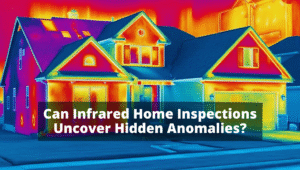
Thermal imaging helps reveal hidden insulation gaps and moisture inside walls.
Infrared inspections help find problems that regular inspections can miss. For instance, they can catch small air leaks or temperature changes that lead to bigger issues. Because of that, this kind of inspection can save time and money.
Thermal cameras can show where insulation is missing, damaged, or put in wrong. Instead of crawling in the attic, an inspector can simply scan the walls and ceilings. This helps make your home more energy efficient.
Air from outside can sneak in through cracks near windows, doors, and attic hatches. That changes the surface temperature nearby. As a result, thermal images make it easier to find and fix air leaks.
Water makes surfaces cooler than usual. Thermal cameras can spot these cool spots behind walls or ceilings. This helps catch leaks early, before they cause mold or other damage.
“Mold remediation can be costly and disruptive, so early detection is crucial.” — U.S. Department of Energy
To learn more, visit Energy.gov’s guide on thermographic inspections.
It takes special training to read thermal images the right way. Materials like plaster or stone can hide heat differences. If not done right, the results might be wrong or confusing.
Several things can affect how well infrared inspections work. For example, the temperature inside and outside should differ by at least 20°F. Also, wind or sunlight can change the results.
Keep in mind, infrared cameras don’t see through walls. Instead, they show surface heat. Heavy materials like stone can make the images harder to read.
Infrared inspections help find problems that may go unnoticed. These include moisture, missing insulation, air leaks, HVAC issues, or electrical faults. Finding these early can help you avoid big repair bills and save energy.
In the end, thermal imaging protects your home and your wallet. It’s a smart, non-invasive way to keep your home safe and energy efficient, especially in Oklahoma.
Q: What are Infrared Home Inspections?
A: They use thermal cameras to find hidden problems in your home.
Q: How do they work?
A: The camera shows temperature changes. Inspectors use these images to spot warning signs.
Q: What can they detect?
A: They can find leaks, missing insulation, air leaks, HVAC issues, and electrical hot spots.
Q: When should I schedule one?
A: Before buying or selling a home, after renovations, or if you notice drafts, high energy bills, or moisture.
Q: How long does it take?
A: Usually about an hour, depending on the size of your home and the number of issues.